|
Regional History History of Timbering County Histories Calhoun County Franklin County Gadsden County Gulf County Jackson County Liberty County Wakulla County |
History: Wakulla County
A Brief Chronology of Wakulla County
The name “Wakulla” is believed to be of Native American origin, perhaps meaning “spring of water” (kala). Another theory holds that the name comes from a Creek word meaning “loon.” The most popular interpretation is “mysterious waters.”
Prehistory
Evidence of human presence at Wakulla Spring goes back to the Paleoindian Period (15,000 BC - 8,000 BC) and continues through the Archaic (8,000 - 5,000 BC). The earliest people were probably nomadic, moving with the seasons. Eventually, people settled and started to farm and trade with neighboring groups. The first Spanish explorers in the region encountered members of the Apalachee tribe, a powerful group that farmed territory between the Aucilla and Ochlockonee rivers. Spanish accounts describe an Apalachee town near the coast called Aute, which may have been between Wakulla Spring and Crawfordville. Archaeologists have found ceramics on the south bank of the Wakulla River 1/2 mile east of Wakulla Springs Lodge, suggesting this was the site of Aute. Included in the find were a few shards of Spanish olive jars very similar to those found in de Soto's campsite in Tallahassee.
1528 - Arrival of the first Europeans in Wakulla County
A band of gold-seekers led by Panfilo de Narvaez came north from Tampa Bay in 1528 and were probably the first Europeans to see what is now Wakulla County. Hernando de Soto followed the footsteps of de Narvaez, arriving in 1539 and spending the winter in the Apalachee town of Iniachica, which is now part of Tallahassee.
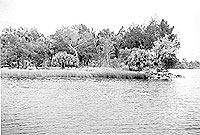 Confluence of the Saint Marks and Wakulla rivers at Fort San Marcos de Apalache. Photo Credit: Florida Photographic Archives |
1804 - Forbes Purchase
Panton, Leslie and Company--traders who did a lot of business with Native Americans--persuaded Creeks and Seminoles to sign over some 1.5 million acres between the Apalachicola and Wakulla rivers, purportedly to pay off debts incurred by the tribes in the traders' stores. The business was renamed John Forbes and Company, and the deal went down in history as the Forbes Purchase. In 1819, an American named Colin Mitchell bought the whole thing for $110,000. Mitchell sold it off in pieces to pay his debts.
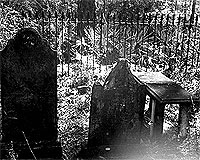 Magnolia Cemetery. Photo Credit: Florida Photographic Archives |
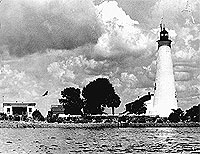 St. Mark's Lighthouse in the 1950's. Photo Credit: Florida Photographic Archives |
1830s - Establishment of Newport
Daniel Ladd, a nephew of the Hamlin brothers, helped establish the town of Newport on the St. Marks River. It became an economic center, with as many as 1,500 inhabitants, a dozen large stores, warehouses, wharves, and stills. Newport became the county seat in 1844. In 1846, the Wakulla Hotel was built next to a sulfur spring, marketed as a health resort for the medicinal quality of the mineral water. The town was seriously damaged during the Civil War. Once Florida's second largest city, Newport had fewer than 30 residents by 1872. Newport revived for a few years during World War II, when PT boats were built there.
1837 - Completion of the Tallahassee-St. Marks Railroad
The Tallahassee--St. Marks Railroad was chartered in 1834 and in operation by 1836, making it among the first railroads in Florida. It was operated by mule and later converted for use by steam engines. The line was extended to Port Leon in 1839, but the town was destroyed by a hurricane in 1843. The railroad remained in operation for 147 years. In 1984 it became the Tallahassee-St. Marks Historic Railroad State Trail.
1838 - Founding of Port Leon
The demise of Magnolia led to the founding of Port Leon in 1838. The site about 3 miles south of the present town of St. Marks in what is now the St. Marks National Wildlife Refuge. Territorial Governor Richard Call extended the Tallahassee-St. Marks rail line to Port Leon in 1839. Port Leon became the county seat of Wakulla but was destroyed by a hurricane and storm surge on March 11, 1843, and its residents moved upriver to Newport.
1843 - Establishment of Wakulla County
1845 -Arrival of Dr. John L. Crawford
Dr. John L. Crawford was a Georgia native who moved to Wakulla County in 1845 to practice medicine and to farm. Dr. Crawford served in the Florida House of Representatives and the state Senate, and he was Florida's Secretary of State for 20 years. (His son succeeded him and served for 29 years.) In 1866, the county seat was moved to Crawfordville from Newport and named in his honor. Dr. Crawford is buried in the Old City Cemetery in Tallahassee.
1851 - Start of construction of the Plank Road
The Georgia and Florida Plank Road Company began construction of Plank Road in 1851 to connect Newport with southern Georgia. It only got as far as Leon County, however.
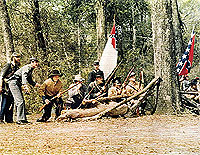 First reenactment of the Battle of Natural Bridge (1975). Photo Credit: Florida Photographic Archives |
1868 - Conflagration at St. Marks
After the Civil War, the town of St. Marks resumed its flourishing trade, but in 1868 the business portion of the town was destroyed by fire. Six large warehouses, a wharf, several ice houses, and a steam cotton press were destroyed and never rebuilt.
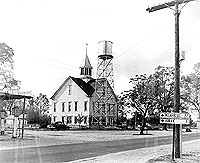 Old Wakulla County courthouse. Photo Credit: Florida Photographic Archives |
1895 - Founding of the towns of Sopchoppy and Panacea
Like many Florida place names of Native American origin, the original meaning of “Sopchoppy” is not known for certain. Its most popular interpretation is “dark water river,” but some believe it comes from Creek words meaning “long” and “twisted,” and others think it's a corruption of another Creek word for “red oak.” (Although not terribly long, the Sopchoppy River is both twisted and dark.) The town was surveyed in 1895 for the Georgia, Florida, and Alabama Railroad. John Calhoun, the surveyor, is said to be the founder of Sopchoppy. By 1910, Sopchoppy was the largest incorporated town in the county, serving Greenough, Ashmore, Smith Creek, Sanborn, and Buckhorn.
W.C. Tully founded Panacea, named for the healing properties of its mineral springs. The Panacea Mineral Springs Hotel held 125 guests. It was burned to the ground in the 1920s. Another large motel was the Bay View Inn on Dickerson Bay. This hotel was torn down in the 1950s. Panacea prospered during World War II thanks to U.S. Army Camp Gordon Johnston, located in neighboring Franklin County.
1915 - Founding of the Wakulla Beach Community
Henry Walker Sr. developed the Wakulla Beach community. Three hotels were built there beginning in 1915. It is said to have been Florida's first subdivision, although it never attracted residents in any number.
1925 - Purchase of Wakulla Spring by George T. Christie
Jacksonville real estate developer George T. Christie bought the spring and 270 acres for $14,000 and promoted it as a tourist attraction with glass-bottom boats and a pier. In 1930, Christie's employees found mastodon bones in the spring run, and he called in the Florida Geological Survey to help excavate them. A nearly complete skeleton was assembled and is now in the Museum of Florida History in Tallahassee.
1930 - Founding of Shadeville High School
Shadeville High School was created in 1930 and served as the county's black high school until 1968.
1934 - Purchase of Wakulla Spring by Edward Ball
Edward Ball, brother-in-law of Alfred I. du Pont, bought the spring, although the purchase price isn't known. Eventually, he owned almost 4,000 acres around the spring and along the Wakulla River. He built the Wakulla Springs Lodge, which opened in 1937, and built a bulkhead and a white sand beach at the spring. The lodge is now owned by the State of Florida and is listed in the National Register of Historic Places.
1949 - Completion of the current Wakulla County courthouse
1986 -Purchase of Wakulla Spring by the State of Florida
Despite the objections of the Wakulla County Commission, the State of Florida bought the spring, the lodge, and 3,000 acres around it for $7.15 million.
2002-2004 - Research on the source of Wakulla Spring's waters
Using dyes to trace the path of water, scientists began to map the connections between sinkholes, disappearing streams, and Wakulla Spring. Divers from the Woodville Karst Plain Project map miles of caverns and conduits bringing water to the spring.
REFERENCES
Division of Historical Resources, Department of State, State of Florida:
Name Origins of Florida Places
[http://dhr.dos.state.fl.us/flafacts/city3.html]
Florida Historical Markers Program
[http://dhr.dos.state.fl.us/bhp/markers/markers.cfm?ID=wakulla]
Florida League of Cities, Inc., City Trivia
[http://www.flcities.com/membership/city_trivia_pt.asp#s]
Kilgore, J. n.d. Old St. Marks in Florida: an historical work.
Page, E. 2001. Images of America: Wakulla County. Arcadia Publishing, Charleston, SC.
Revels, T. J. 2002. Watery Eden: A History of Wakulla Springs. Sentry Press, Tallahassee, FL.
St. Marks National Wildlife Refuge webpage [http://saintmarks.fws.gov/lighthouse.html]
Wakulla County Chamber of Commerce
[http://www.wakullacounty.com/Chamber/court_house.htm]
Note: The content of the website has not been updated since 2005. The site remains online for it's value as legacy content and is unlikely to be updated.